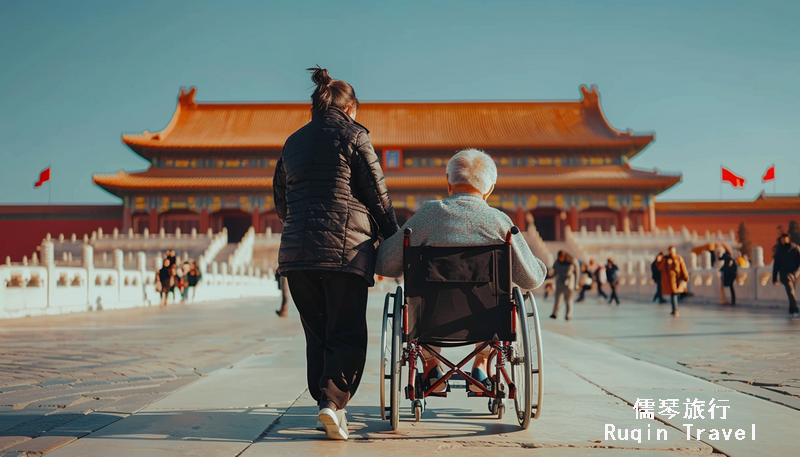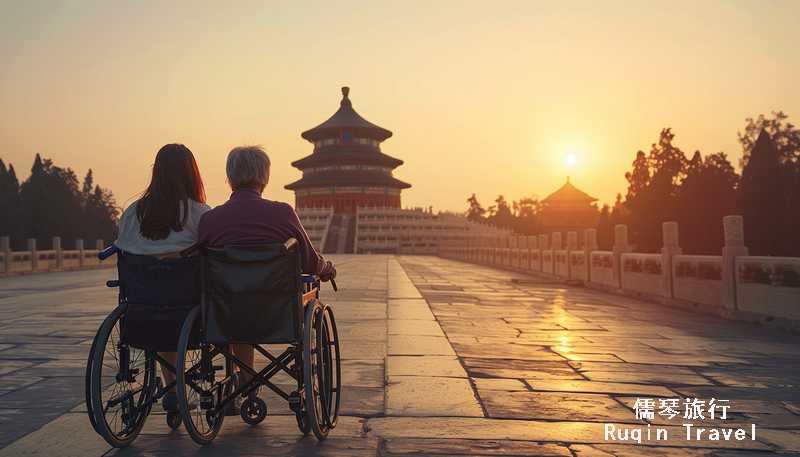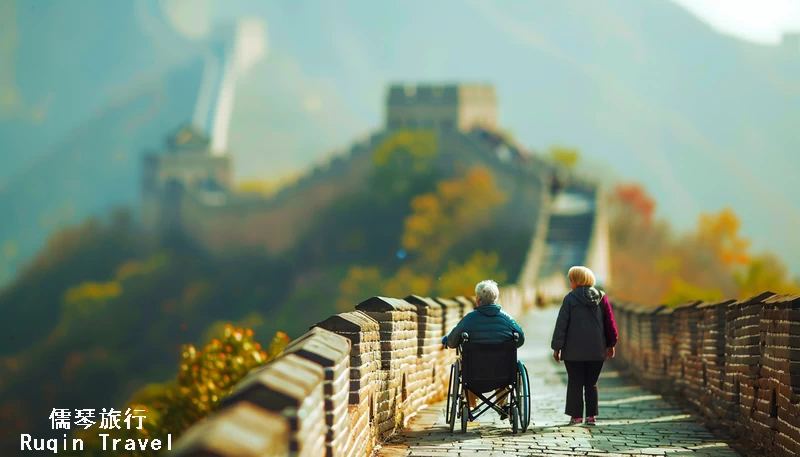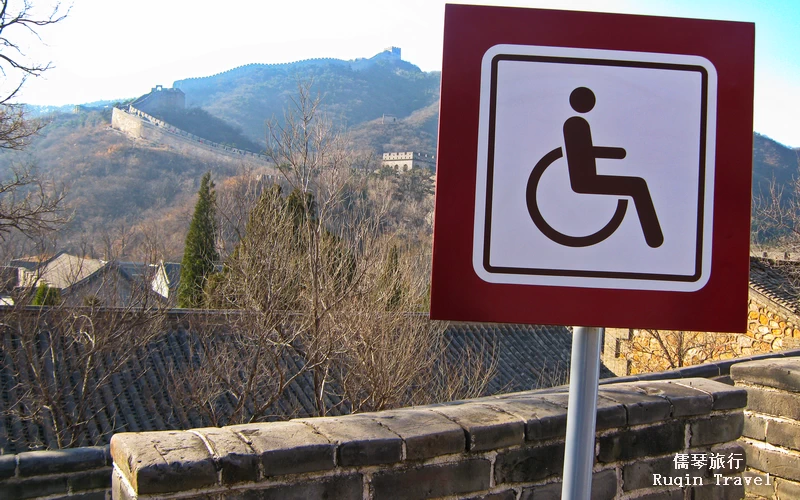Welcome to Beijing, a city where history intertwines with modernity, offering a uniquely accessible experience for wheelchair users. In this “Beijing Wheelchair Accessible Travel Guide”, we’ll explore the best ways to enjoy Beijing’s major attractions with ease and comfort.
Beijing Enhances Barrier-Free Facilities for the Disabled
Beijing has significantly improved its barrier-free facilities, spurred by hosting the Winter Paralympic Games. This has made life more convenient for the elderly and disabled.
Resident Du Peng, a wheelchair user and inspector, noted increased accessibility. In three years, Beijing installed barrier-free facilities in 336,000 places, built 100 wheelchair-accessible streets, and created 100 “convenient life circles” within 15 minutes of homes.
Since November 2019, the city’s accessibility action plan has upgraded sidewalks, service centers, and more. Subway Lines 1 and 2 added stair climbers and platform lifts, and 12,000 buses now have wheelchair-accessible features. Hospitals and public toilets also saw improvements.
The Forbidden City
The Forbidden City, once the imperial palace of Ming and Qing dynasties, now stands as a testament to China’s rich history, readily welcoming wheelchair users. The Forbidden City is one of the major attractions in Beijing good for Wheelchair Accessible Travel.

Recent upgrades have introduced ramps at main entrances and along major pathways, though a few areas might still pose a challenge due to uneven surfaces. For an enhanced experience, consider renting an accessible audio guide, providing a deeper insight into the imperial past.
Practical Travel Tips
- Advance Planning: Book tickets online to avoid long queues. The East Gate entrance tends to be less crowded.
- Wheelchair Rental: Wheelchairs are available for rent at the entrance.
- Rest Areas: Look out for designated rest areas where you can take breaks.
Temple of Heaven
Surrounded by a serene park, the Temple of Heaven is a fine example of Ming architecture. Wheelchair accessibility here is commendable, with flat paths and ramps throughout the park.

While some areas of the temple have steps, the main halls are accessible. An early morning visit is recommended to avoid crowds and immerse in the tranquility of this spiritual site.
Practical Travel Tips
- Best Visiting Time: Early morning or late afternoon visits are less crowded.
- Accessible Restrooms: Located near the main entrances and the Hall of Prayer for Good Harvests.
- Guided Tours: Consider a guided tour for insightful stories and easier navigation.
Summer Palace
The Summer Palace, an imperial garden, offers good accessibility. The pathways around Kunming Lake are smooth, perfect for wheelchairs, though some historic structures have steps, but the main walkways and garden areas are accessible.
Don’t miss a wheelchair-friendly boat ride on Kunming Lake for a unique perspective of the palace’s exquisite beauty.
Practical Travel Tips
- Boat Ride: Accessible boat rides offer a unique view of the palace and the lake.
- Map Guidance: Use the map available at the entrance to plan an accessible route.
- Weather Consideration: Visit in the morning or late afternoon to avoid midday heat.
Beijing Zoo & Panda House
Beijing Zoo, known for its pandas, is largely accessible with flat paths and ramps throughout, including the Panda House. A pro tip: check the feeding times for pandas to enhance your visit with these adorable creatures.
Practical Travel Tips
- Panda Viewing: Arrive early at the Panda House for the best viewing experience.
- Feeding Times: Check the zoo’s schedule for animal feeding times for a more interactive experience.
- Seating Areas: Frequent seating areas are available throughout the zoo for rest.
Great Wall of China (Badaling Section)
The Great Wall at Badaling, the most accessible section, offers a special pathway for wheelchair users. To avoid crowds and enjoy a more serene experience, consider visiting on weekdays.

Practical Travel Tips
- Avoid Peak Times: Weekday mornings are less crowded.
- Cable Car Option: A cable car can take you to a more accessible part of the wall.
- Weather Gear: Bring sun protection in summer and warm clothing in winter.
Beijing’s Hutongs
Exploring Beijing’s traditional hutongs offers a glimpse into the city’s cultural heart. Accessibility varies, with some having smoother surfaces than others.
The hutongs near the Bell and Drum Towers are notably more wheelchair-friendly.
Practical Travel Tips
- Best Routes: Focus on hutongs near the Bell and Drum Towers for better accessibility.
- Cultural Interaction: Engage with local artisans and shopkeepers for a genuine hutong experience.
- Evening Visits: Some hutongs have vibrant night markets worth exploring.
Public Transportation
Beijing’s public transportation system, including the subway and buses, is equipped with elevators, tactile paving, and ramps, making it accessible for wheelchair users.
Keep a subway map handy and consider using the Beijing Subway app for navigating accessible routes. Check how to use Beijing subway for more information.
Wheelchair-accessible taxis are another convenient option, best booked in advance through specialized companies or mobile apps catering to travelers with mobility needs.
Practical Travel Tips
- Subway Navigation: Use the Beijing Subway app for real-time information and accessible route planning.
- Taxi Services: Accessible taxis can be booked in advance through specialized companies or apps.
- Travel Cards: Consider getting a transport card for convenience across different modes of public transportatio
Accommodations and Dining
Many hotels and restaurants in Beijing are well-equipped for wheelchair users. When booking accommodations, inquire about accessible rooms and facilities.
For dining, look for venues with step-free entrances and spacious seating. Checking restroom accessibility beforehand is also a wise move.
Practical Travel Tips
- Accommodation Choice: Central locations often have better accessibility to attractions and transportation.
- Dining Options: Research restaurants with accessible entrances and restrooms beforehand.
- Hotel Amenities: Inquire about room specifics like door width, bathroom accessibility, and emergency procedures.
General Tips
Navigating Beijing can be smoother with a phrasebook or translation app, as English isn’t widely spoken everywhere. Many cultural sites are increasingly wheelchair-friendly, but checking their accessibility status beforehand is recommended.
For easier navigation in less accessible areas, consider hiring a guide or traveling with a companion. Make use of accessibility-focused travel apps and resources for updated information on accessible attractions and facilities in Beijing. Local disability organizations and tourist information centers can also provide valuable advice and assistance.
Beijing, with its blend of ancient and modern elements, continues to improve in terms of accessibility. While some areas might be less accessible, proper planning and assistance can ensure a fulfilling exploration of this culturally rich city. Always stay updated with the latest travel advisories for a safe and enjoyable trip.



